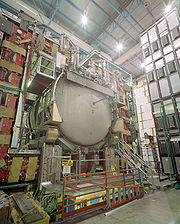
D0 experiment
Encyclopedia


Particle physics
Particle physics is a branch of physics that studies the existence and interactions of particles that are the constituents of what is usually referred to as matter or radiation. In current understanding, particles are excitations of quantum fields and interact following their dynamics...
. DØ was one of two major experiments (the other is the CDF
Collider Detector at Fermilab
The Collider Detector at Fermilab experimental collaboration studies high energy particle collisions at the Tevatron,the world's former highest-energy particle accelerator...
experiment) located at the world's second highest-energy accelerator, the Tevatron Collider
Tevatron
The Tevatron is a circular particle accelerator in the United States, at the Fermi National Accelerator Laboratory , just east of Batavia, Illinois, and is the second highest energy particle collider in the world after the Large Hadron Collider...
, at the Fermilab
Fermilab
Fermi National Accelerator Laboratory , located just outside Batavia, Illinois, near Chicago, is a US Department of Energy national laboratory specializing in high-energy particle physics...
in Batavia
Batavia, Illinois
Batavia was founded in 1833, and is the oldest city in Kane County, Illinois, with a small portion in DuPage County. During the Industrial Revolution, Batavia became known as ‘The Windmill City’ for being the largest windmill producer of the time...
, Illinois, USA.
The research is focused on precise studies of interactions of protons and antiprotons
Proton
The proton is a subatomic particle with the symbol or and a positive electric charge of 1 elementary charge. One or more protons are present in the nucleus of each atom, along with neutrons. The number of protons in each atom is its atomic number....
at the highest available energies. It involves an intense search for subatomic
Subatomic particle
In physics or chemistry, subatomic particles are the smaller particles composing nucleons and atoms. There are two types of subatomic particles: elementary particles, which are not made of other particles, and composite particles...
clues that reveal the character of the building blocks of the universe.
Overview

Fundamental interaction
In particle physics, fundamental interactions are the ways that elementary particles interact with one another...
regions, where proton
Proton
The proton is a subatomic particle with the symbol or and a positive electric charge of 1 elementary charge. One or more protons are present in the nucleus of each atom, along with neutrons. The number of protons in each atom is its atomic number....
and antiproton
Antiproton
The antiproton is the antiparticle of the proton. Antiprotons are stable, but they are typically short-lived since any collision with a proton will cause both particles to be annihilated in a burst of energy....
beams intersect, on the Tevatron
Tevatron
The Tevatron is a circular particle accelerator in the United States, at the Fermi National Accelerator Laboratory , just east of Batavia, Illinois, and is the second highest energy particle collider in the world after the Large Hadron Collider...
synchrotron
Synchrotron
A synchrotron is a particular type of cyclic particle accelerator in which the magnetic field and the electric field are carefully synchronised with the travelling particle beam. The proton synchrotron was originally conceived by Sir Marcus Oliphant...
ring, labelled 'DØ'. It is expected to record data until the end of 2011. DØ is an international collaboration of about 550 physicist
Physicist
A physicist is a scientist who studies or practices physics. Physicists study a wide range of physical phenomena in many branches of physics spanning all length scales: from sub-atomic particles of which all ordinary matter is made to the behavior of the material Universe as a whole...
s from 89 universities and national laboratories from 18 countries.
The experiment is a test of the Standard Model
Standard Model
The Standard Model of particle physics is a theory concerning the electromagnetic, weak, and strong nuclear interactions, which mediate the dynamics of the known subatomic particles. Developed throughout the mid to late 20th century, the current formulation was finalized in the mid 1970s upon...
of particle physics
Particle physics
Particle physics is a branch of physics that studies the existence and interactions of particles that are the constituents of what is usually referred to as matter or radiation. In current understanding, particles are excitations of quantum fields and interact following their dynamics...
. It is sensitive in a general way to the effects of high energy collisions and so is meant to be a highly model-independent probe of the theory. This is accomplished by constructing and upgrading a large volume elementary particle
Elementary particle
In particle physics, an elementary particle or fundamental particle is a particle not known to have substructure; that is, it is not known to be made up of smaller particles. If an elementary particle truly has no substructure, then it is one of the basic building blocks of the universe from which...
detector
Particle detector
In experimental and applied particle physics, nuclear physics, and nuclear engineering, a particle detector, also known as a radiation detector, is a device used to detect, track, and/or identify high-energy particles, such as those produced by nuclear decay, cosmic radiation, or reactions in a...
.
The detector is designed to stop as many as possible of the subatomic particle
Subatomic particle
In physics or chemistry, subatomic particles are the smaller particles composing nucleons and atoms. There are two types of subatomic particles: elementary particles, which are not made of other particles, and composite particles...
s created from energy
Energy
In physics, energy is an indirectly observed quantity. It is often understood as the ability a physical system has to do work on other physical systems...
released by colliding proton/antiproton
Proton
The proton is a subatomic particle with the symbol or and a positive electric charge of 1 elementary charge. One or more protons are present in the nucleus of each atom, along with neutrons. The number of protons in each atom is its atomic number....
beams. The interaction region where the matter
Matter
Matter is a general term for the substance of which all physical objects consist. Typically, matter includes atoms and other particles which have mass. A common way of defining matter is as anything that has mass and occupies volume...
–antimatter
Antimatter
In particle physics, antimatter is the extension of the concept of the antiparticle to matter, where antimatter is composed of antiparticles in the same way that normal matter is composed of particles...
annihilation
Annihilation
Annihilation is defined as "total destruction" or "complete obliteration" of an object; having its root in the Latin nihil . A literal translation is "to make into nothing"....
takes place is close to the geometric center of the detector. The beam collision area is surrounded by tracking chambers in a strong magnetic field
Magnetic field
A magnetic field is a mathematical description of the magnetic influence of electric currents and magnetic materials. The magnetic field at any given point is specified by both a direction and a magnitude ; as such it is a vector field.Technically, a magnetic field is a pseudo vector;...
parallel to the direction of the beam(s). Outside the tracking chamber are the pre-shower detectors and the calorimeter
Calorimeter
A calorimeter is a device used for calorimetry, the science of measuring the heat of chemical reactions or physical changes as well as heat capacity. Differential scanning calorimeters, isothermal microcalorimeters, titration calorimeters and accelerated rate calorimeters are among the most common...
. The Muon
Muon
The muon |mu]] used to represent it) is an elementary particle similar to the electron, with a unitary negative electric charge and a spin of ½. Together with the electron, the tau, and the three neutrinos, it is classified as a lepton...
Chambers form the last layer in the detector. The whole detector is encased in concrete blocks which act as radiation shields. About 1.7 million collisions of the proton and antiproton beams are inspected every second and about 100 collisions per second are
recorded for further studies.
Higgs boson
One of the main physics goal of the DØ Experiment is the search for the Higgs bosonHiggs boson
The Higgs boson is a hypothetical massive elementary particle that is predicted to exist by the Standard Model of particle physics. Its existence is postulated as a means of resolving inconsistencies in the Standard Model...
predicted by the Standard Model
Standard Model
The Standard Model of particle physics is a theory concerning the electromagnetic, weak, and strong nuclear interactions, which mediate the dynamics of the known subatomic particles. Developed throughout the mid to late 20th century, the current formulation was finalized in the mid 1970s upon...
of Particle Physics. The LEP experiments at CERN
CERN
The European Organization for Nuclear Research , known as CERN , is an international organization whose purpose is to operate the world's largest particle physics laboratory, which is situated in the northwest suburbs of Geneva on the Franco–Swiss border...
have excluded the existence of such a Higgs boson with a mass smaller than . The combined measurements of the DØ and CDF experiments reported in January 2010 exclude a Higgs boson with a mass between 162 and .
Top quark
On March 4, 2009, the DØ and CDF collaborations both announced the discovery of the production of single top quarkTop quark
The top quark, also known as the t quark or truth quark, is an elementary particle and a fundamental constituent of matter. Like all quarks, the top quark is an elementary fermion with spin-, and experiences all four fundamental interactions: gravitation, electromagnetism, weak interactions, and...
s in proton-antiproton collisions. This process occurs at about half the rate as the production of top quark pairs but is much more difficult to observe since it is more difficult to distinguish from other processes that happen at much higher rate. The observation of single top quarks is used to measure the element Vtb of the CKM matrix
Cabibbo-Kobayashi-Maskawa matrix
In the Standard Model of particle physics, the Cabibbo–Kobayashi–Maskawa matrix is a unitary matrix which contains information on the strength of flavour-changing weak decays...
.
B mesons
From a press release dated June 13, 2007:Physicists of the DZero experiment at the Department of Energy's Fermi National Accelerator Laboratory have discovered a new heavy particle, the Ξb baryon, with a mass of , approximately six times the proton mass. The newly discovered electrically charged Ξb baryon, also known as the "cascade b," is made of a down, a strange and a bottom quark. It is the first observed baryon formed of quarks from all three families of matter. Its discovery and the measurement of its mass provide new understanding of how the strong nuclear force acts upon the quarks, the basic building blocks of matter.

